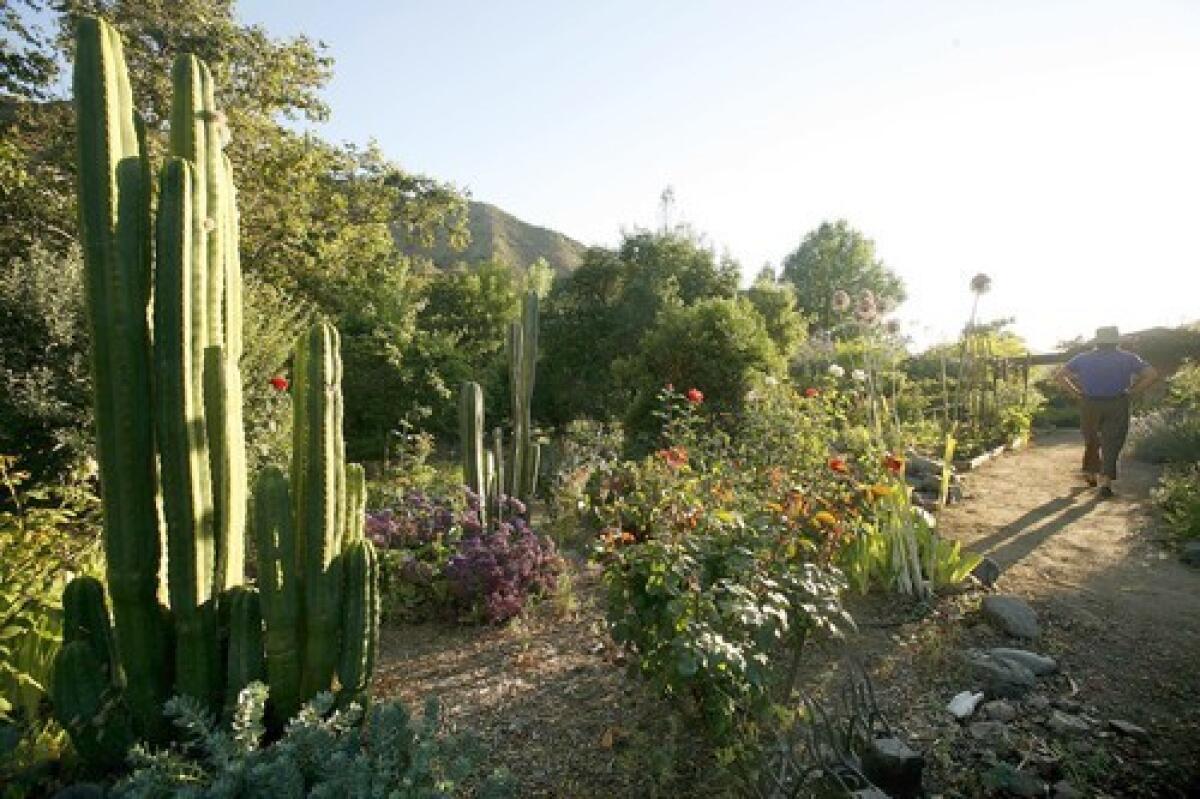A Modjeska Canyon’s garden water-wise ways

SARAH SARKISSIAN scrambles up a hillside charred by wildfire last October in Modjeska Canyon, in the dry wilds of Orange County. Charcoaled skeletons of century-old olive trees reach up around her like huge upended velvety spiders. She finds what she’s looking for.
“When are you ever going to see this again?” she asks, referring to a regenerated colony of calochortus. The elusive wildflowers, known as Mariposa lilies, are blooming lavender and the rare, blushing white. “We thought everything was gone. We never thought they’d come back.”
Sarkissian, whose nearby house was untouched by fire, is a passionate lover of dry landscape with the eye of an artist and the mind of an engineer. Talk to her about earth, wind, fire and especially water -- she knows exactly what it takes to have a water-wise yet bountiful garden in Southern California.
If gardens are autobiography, Sarkissian has spent 13 years writing hers on canyon land. High school teacher, water harvester and amateur botanist, she lives with husband Geoff on a creek-hugging acre that includes a front garden that is 75% irrigation-free. The backyard too is carefully designed not to waste a drop of water with plenty of California natives and other dry-habitat plants that bring beauty and tranquillity with minimal use of hose and not one sprinkler.
Sarkissian is auteur and fierce editor of an elegant garden that echoes this canyon habitat. “The whole canyon is my garden,” Sarkissian says. “To me it’s the most amazing place in Orange County.”
This slender woman has engaged this land and environment with intimacy, passion -- and patience. The couple have lived in the modest house they built since 1989 but did not begin to garden until seven years later. Sarkissian walked the land, watched the light, observed wildlife, learned about native plants and water harvesting, revived their clay fill soil (“the worst,” she says), and took in what it means to live with threats of fire and flood.
In 1993, the Sarkissians commissioned landscape architect Lisa Iwata of Land Interactive to plan the front garden. They had a wish-list of 80 California chaparral and desert plants; Iwata chose 50; there are now 42.
“We wanted a coherent design,” says Sarkissian, “not just a collection of plants.”
Among the challenges: a yawning county-built concrete flood-control channel (read: ditch) marching from street to creek. A modified Iwata plan went into the ground in 1995 and constantly evolves, as gardens do.
Water harvesting was key.
“Keeping water on one’s lot is a major principle of xeriscape,” Sarkissian says.
Theirs was designed for “sheet flow” drainage off the hills and street above their land. In the front garden, a rock-lined “dry creek” was built at Iwata’s suggestion -- this is the hinge point of water flow, where surface water runs during heavy rain.
The system is designed to feed the backyard too. Any water from the driveway spills into an underground drain directed to native sycamores. Drainage from the south side of the roof irrigates the roses and other native trees. Missing, by design, from this property: elaborate hardscape drain systems, grass, and heavy doses of water and soil contaminants.
Iwata cautions that water harvesting is not a one-size-fits-all idea. The Sarkissians’ method fits their rural, riparian landscape; homeowners intrigued by water harvesting should consult a water-management professional.
Such practicalities were crucial, but for Sarkissian, beauty was also key.
In the front garden is a glen of California live oaks, visible from the street. Sarkissian considers it “one of the most interesting things we’ve done.” A bit of open space lightly mulched with oak litter separates the glen from lovely specimen shrubs -- manzanita, sugarbush, white sage, and in the heart of this garden, a gorgeous flannel bush (Fremontodendron), and a western redbud. The flowers of the flannel bush are used as mulch, and the redbud is “encircled by its own red-hued leaves,” Sarkissian says. Paths run through the plantings, along with the dry creek bed. These plants are only hand-watered monthly in summer.
Closer to the house, irrigated plantings of Pacific Coast iris, columbine, white flowering currant, lavender, coral bells and bush anemone flower in season. A California bay tree flanked by nonnative snow-in-summer anchors a corner of a path. Along the ditch, almond and pecan trees, desert willow and other plantings soften its visual impact and screen a neighbor’s property. (The front garden recently won top honors in the California Friendly Garden Contest sponsored by Roger’s Gardens in Corona del Mar.)
A deck wraps around close to the entire perimeter of the house, expanding its space; the richly planted, spacious backyard slopes to Santiago Creek. This rear yard is an assemblage of small gardens, sitting areas, an orchard and an artfully sited utility yard, where an office and sheds serve the family and a dog run serves Bella, a young Vizsla.
The land here is productive -- vegetable gardens (Sarkissian loves cantaloupe and is trying to replicate a much-remembered perfect crop), and apple, pear, plum, peach, cherry, nectarine, avocado and pluot trees are “planted in an arc like a fishhook.” Surprises abound -- roses entwine prickly pear; camellias and espaliered apples delight; the beauty of the rugged ridgeline stuns.
Irrigation is divided into zones. Roses and vegetables near the house are watered regularly; the small orchard receives infrequent deep watering along with some ornamentals; California native plants and trees aren’t irrigated at all.
Paths meander down the slope through the backyard to the creek -- Sarkissian wanted indirect paths to increase a visitor’s perception of space and follow the direction of the light. In the riparian zone too, Sarkissian’s thoughtful ideas prevail. She’s ripped out nonnative ivy, built a dry stone wall that won’t impede the creek if flooding brings it down, and planted California blackberries and lemonade berry along the banks.
Recently, a tornado and flood flew through the canyon. “The water came up in 40 minutes,” Sarkissian says, but the deep roots of the less-than-2-year-old creek-side plants held.
“To live in chaparral and have a creek in this canyon is amazing,” she says. “It is a privilege and a responsibility to live here and not waste it.
“We are so lucky that it didn’t burn down. I would have been just as upset to lose the garden as the house. I guess we would have had to rebuild.” Sarkissian is quiet for a moment as she looks at the creek and reflects on her time here. “But you just don’t have that many 13-year periods of your life.”
--
Paula Panich is an author of garden books.
--
For the native reader
ON a garden timeout during the summer? Why not use the hiatus to bone up on water-saving plants and designs. Here are some idea books:
Sarah Sarkissian’s favorites:
“Designing With Plants,” by Piet Oudolf with Noel Kingsberg.
“The New Perennial Garden,” by Noel Kingsberg.
“California’s Wild Gardens: A Guide to Favorite Botanical Sites,” edited by Phyllis M. Faber.
Additional readings:
“The Cactus Family,” by Edward F. Anderson. A reprint of the 1932 classic.
“California Native Plants for the Garden,” by Carol Bornstein, David Fross and Bart O’Brien.
“Designing California Native Gardens,” by Glenn Keator and Alrie Middlebrook.






